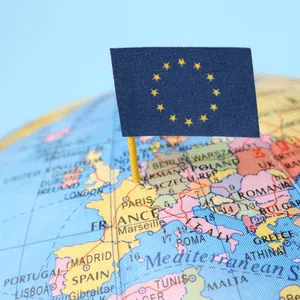A review of Shanghai’s new recycling system
It has been one month since Chinese president Xi Jinping invited the municipality of Shanghai to take the lead in a nationwide effort to tackle China’s waste problem by introducing waste recycling.
Shanghai has introduced a four-fold municipal solid waste separation at source. This helps to stratify the waste at the origin – the households and businesses – and allows for greater return on investment at recycling facilities. The most important value-added is, however, the separation of organic waste from other forms of waste.
China is a country that extensively uses municipal solid waste incineration (1. Ji, 2016). If municipal solid waste is too wet – I.e. the percentage of organic waste matter is too high – incineration plants become inefficient (2. Weathersby, 2019). The calorific value associated with paper, plastic or similar components is much higher than the calorific value of organic waste. By separating organic waste from other forms of waste, incineration plants will no longer need to co-fire with fossil fuels such as abundant but dirty coal or cleaner natural gas that suffers from chronic shortage in the Middle Kingdom. In other words, source separation of organic waste from waste with higher calorific value will be a real game-changer as I have pointed out in my publications in 2014 and 2016 (3. Rech, 2014; 4. Rech, 2016).
Organic waste is a valuable resource in itself. Waste to Energy (WtE) via anaerobic digestion or other forms of organic waste fermentation can produce biological forms of gas and thereby address three challenges China faces at the same time:
- Biological gas from organic waste provides China with supply-side diversification by offering an additional source of gas for the country that is importing the majority of its natural gas demand from Turkmenistan and increasingly Russia with a new pipeline that is called ‘Power of Siberia’ to be completed in December 2019 (5. Downs, 2019; 6. Zou et.al., 2018; 7. Foy, 2018; 8. Trakimavičius, 2019).
- Biological gas from organic waste provides the country with much needed flexible renewable energy that offers both centralised and decentralised solutions. Biological gas is a relatively mobile source of energy that can be fed into the system of pipelines and transported across distance in a centralised system infrastructure. Alternatively, biological gas can be used for energy production on demand in decentralised and relatively small on-site facilities. Companies like Enwise that provide modular B2B solutions and recently received investment from Suez and Lingang Group are a good case in point (9. Enwise, 2019a; 10. Enwise, 2019b). For full disclosure, we have worked with them over the past couple of months, and while I appreciated the flexibility of their modular approach, there are plenty of other actors in this market segment with similar solutions.
- Biological gas from organic waste provides an alternative to pesticides in agricultural use in a country that is desperately trying to clean up its act with regards to air, water, and soil pollution. Organic waste can initially be used to produce biological gas. The residue from this process can be brought out as organic fertiliser onto the fields. This is much more sustainable than the residue from waste incineration, namely a highly toxic sludge with little further use that is landfilled and in turn threatens to pollute the air, water, and soil (2. Rech, 2014; 11. Srivastava et.al., 2016).
In other words, it is to be warmly welcomed that the municipality of Shanghai has now introduced waste separation at source. It will take a little bit of time, of course, until all Chinese citizens have internalised the hierarchy of environmental action that is ‘Reduce – Reuse – Recycle’. However, I am sure that China’s people will soon be as diligent about waste separation at source as are the people in my home country Germany. In that sense, it is great that China gets moving in this domain and for companies active in the recycling business, China’s initiative offers plenty of market opportunity and other countries in South East Asia are rapidly following suit. Let’s seize this business opportunity while doing the right thing for our planet.
Maximilian RECH / 睿马克
Director of Studies & Assistant Professor in International Affairs
ESSCA School of Management – Shanghai
297 Wusong Lu, 4th floor, 200080 Shanghai, China
中国上海市虹口区吴淞路297号4楼
www.essca.fr | LinkedIn | Twitter | EU*Asia Institute
References
- Ji, L.; Lu, S.; Yang, J.; Du, C.; Chen, Z.; Buekens, A.; Yan, J. (2016). Municipal solid waste incineration in China and the issue of acidification: A review. Waste Management & Research 2016, Vol. 34(4) 280 –297. Retrieved from: https://www.researchgate.net/publication/297585340_Municipal_solid_waste_incineration_in_China_and_the_issue_of_acidification_A_review [accessed on 01 August 2019].
- Weatherby, C. (2019). Waste-to-energy: A renewable opportunity for Southeast Asia? China Dialogue. Retrieved from: https://www.chinadialogue.net/article/show/single/en/11093-Waste-to-energy-A-renewable-opportunity-for-Southeast-Asia- [accessed on 01 August 2019].
- Rech, M. (2014). Municipal solid waste management – implementing best practices in Europe & Asia. In Gaborit, P. (Ed.). EAST – Euro-Asia Sustainable Towns. From pilot to sustainable towns: Satellite cities and metropolitan governance. Retrieved from: https://www.amazon.com/European-Asian-Sustainable-Towns-Metropolises/dp/287574187X [accessed on 01 August 2019].
- Rech, M. (2016). Why waste it? European Chamber of Commerce in China. EuroBiz Magazine. Retrieved from: https://www.eurobiz.com.cn/why-waste-it/ [accessed on 01 August 2019].
- Downs, E. (2019). Testimony before the U.S.-China Economic and Security Review Commission. Hearing on An Emerging China-Russia Axis: Implications for the United States in an Era of Strategic Competition. Retrieved from: https://www.uscc.gov/sites/default/files/Downs_Testimony…pdf [accessed on 01 August 2019].
- Zou, C.; Zhao, Q.; Chen, J.; Li, J.; Yang, Z.; Sun, Q.; Lu, J.; Zhang, G. (2018). Natural gas in China: Development trend and strategic forecast. Natural Gas Industry B Volume 5, Issue 4, July 2018, Pages 380-390. Retrieved from: https://www.sciencedirect.com/science/article/pii/S2352854018300779 [accessed on 01 August 2019].
- Foy, H. (2018). Russia’s $55bn pipeline gamble on China’s demand for gas. Financial Times. Retrieved from: https://ig.ft.com/gazprom-pipeline-power-of-siberia/ [accessed on 01 August 2019].
- Trakimavičius, L. (2019). What China’s appetite for gas could mean for the world. Asia Times. Retrieved from: https://www.asiatimes.com/2019/05/opinion/what-chinas-appetite-for-gas-could-mean/ [accessed on 01 August 2019].
- Enwise (2019a). Enwise Product Launch Event. Retrieved from: https://u.eqxiu.com/s/5gtSANwy?eqrcode=1&share_level=1&from_user=201907039036099b&from_id=c958774e-1&share_time=1562149475331&from=groupmessage&isappinstalled=0 [accessed on 01 August 2019].
- Enwise (2019b). About us. Retrieved from: http://www.enwise.io/ [accessed on 01 August 2019].
- Srivastava, V., de Araujo, A.S.F., Vaish, B. et al. (2016). Biological response of using municipal solid waste compost in agriculture as fertilizer supplement. Reviews in Environmental Science and Bio/Technology. December 2016, Volume 15, Issue 4, pp 677–696. Retrieved from: https://link.springer.com/article/10.1007/s11157-016-9407-9 [accessed on 01 August 2019].






